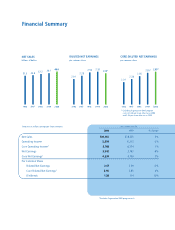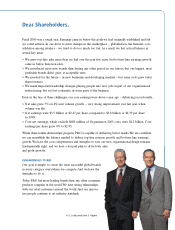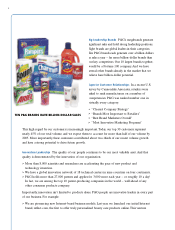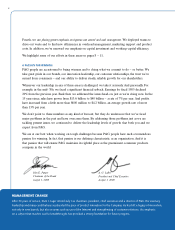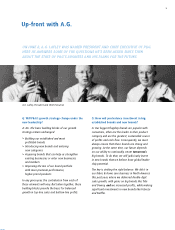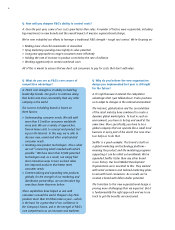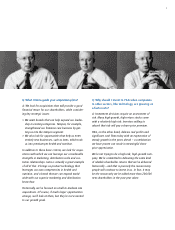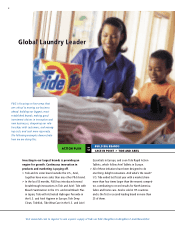Proctor and Gamble 2000 Annual Report Download - page 8
Download and view the complete annual report
Please find page 8 of the 2000 Proctor and Gamble annual report below. You can navigate through the pages in the report by either clicking on the pages listed below, or by using the keyword search tool below to find specific information within the annual report.
6
Q: Why do you believe the new organization
design you implemented last year is still right
for the future?
A: It’s right because it extends the competitive
advantages that I just talked about. It also positions
us to adapt to changes in the external environment.
The Internet, globalization and the consolidation
of the retail industry have combined to create a
dynamic global marketplace. To lead in such an
environment, you have to be big and small at the
same time. More specifically, you have to be a
global company that can operate like a small local
business in every part of the world. Our new struc-
ture helps us to do that.
Swiffer is a good example. This brand is built on
a global marketing and technology platform –
meaning the product and the marketing programs
supporting it can be rolled out worldwide. We’ve
expanded Swiffer faster than any other brand
in our history. Our local Market Development
Organizations were essential to this. They worked
with retail customers and tailored marketing plans
to win with local consumers. As a result, we’ve
created a brand with billion-dollar potential.
The transition to this new organizational design is
proving more challenging than we expected. But it
is fundamentally the right approach and we’re on
track to get the benefits we envisioned.
Q: What do you see as P&G’s core source of
competitive advantage?
A: P&G’s core strength is its ability to build big,
leadership brands. Our goal is to continue doing
that better and more consistently than any other
company in the world.
Our success in building brands is based on
three factors:
>Understanding consumer needs. We talk with
more than 5.5 million consumers worldwide
every year. We use a variety of approaches,
from in-home visits to concept and product test-
ing via the Internet. In this way, we’re able to
discover new, unmet and often unarticulated
consumer needs.
>Inventing new product technologies. This is what
we call “connecting what’s needed with what’s
possible.” We have more than 27,000 patented
technologies and, as a result, can simply find
more innovative ways to turn our best ideas
into improved products that better meet
consumer needs.
>Commercializing and expanding new products
globally. On the strength of our marketing and
distribution partnerships, we can introduce big,
new ideas faster than ever before.
These capabilities have helped us win with
consumers around the world. Shoppers buy P&G
products more than 20 billion times a year – which
is the basis for a great deal of our confidence in
the Company’s future, and in the strength of P&G’s
core competencies as an innovator and marketer.
Q: How will you sharpen P&G’s ability to control costs?
A: Over the past year, some of our costs grew faster than sales. A number of factors were responsible, including
big investments in new brands and the overall impact of massive organizational change.
We’ve now redoubled our efforts to leverage a traditional P&G strength – tough cost control. We’re focusing on:
>Making more choiceful investments in innovation
>Tying marketing spending more tightly to sales potential
>Using new approaches to target consumers more efficiently
>Holding the rate of increase in product costs below the rate of inflation
>Working aggressively to contain overhead costs
All of this is meant to ensure that we don’t ask consumers to pay for costs that don’t add value.


